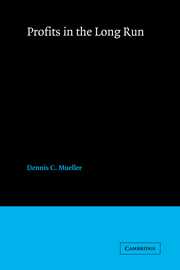Book contents
- Frontmatter
- Contents
- Acknowledgments
- 1 The persistence of firms
- 2 The persistence of profits above the norm
- 3 The persistence of market power
- 4 Profitability and market structure
- 5 The results in perspective
- 6 Profitability and the firm's own advertising, patent activity, risk, and other characteristics
- 7 Profitability and managerial control and compensation
- 8 Mergers and profitability
- 9 Mergers and market share
- 10 The threads gathered and conclusions woven
- Appendix 1 Companies studied
- Appendix 2 Industry categories
- Appendix 3 Industry matchings
- Appendix 4 Assets acquired data (Chapter 7)
- Appendix 5 Mergers and market share: samples of merging companies
- Notes
- References
- Index
5 - The results in perspective
Published online by Cambridge University Press: 04 May 2010
- Frontmatter
- Contents
- Acknowledgments
- 1 The persistence of firms
- 2 The persistence of profits above the norm
- 3 The persistence of market power
- 4 Profitability and market structure
- 5 The results in perspective
- 6 Profitability and the firm's own advertising, patent activity, risk, and other characteristics
- 7 Profitability and managerial control and compensation
- 8 Mergers and profitability
- 9 Mergers and market share
- 10 The threads gathered and conclusions woven
- Appendix 1 Companies studied
- Appendix 2 Industry categories
- Appendix 3 Industry matchings
- Appendix 4 Assets acquired data (Chapter 7)
- Appendix 5 Mergers and market share: samples of merging companies
- Notes
- References
- Index
Summary
The firm-approach model is extremely compact. With industry demand elasticity removed, it purports to explain the difference in longrun profitability across companies with but four variables: two measures of industry product differentiation, advertising and patent intensity, industry concentration, and the firm's market share. Many other variables have been proposed as possible causes of profit differences, and the typical structure-performance model today is a multiequation endeavor with sometimes a score or more of exogenous variables. The next three chapters add a variety of possible explanatory variables to the basic firm-approach model. The main results for this model will prove to be remarkably robust with respect to the addition of other explanatory variables, although some new variables will add significant explanatory power to the equation. Thus, the main novelty of this study, vis-à-vis the structure-performance literature, is already contained in the previous chapter. With this fact in mind, we shall pause in this chapter, before launching into more algebra and econometrics, to consider the results so far obtained, and place them into the context of the existing structure-performance literature.
A major finding of this study is that persistent differences in profitability across companies exist and that these differences are to be explained by a combination of firm- and industry-specific factors. Firms with products that are perceived to have higher quality or those with lower costs have higher profits and market shares and these quality-efficiency advantages become more important as the industry's product structure and technology become more differentiated.
- Type
- Chapter
- Information
- Profits in the Long Run , pp. 85 - 110Publisher: Cambridge University PressPrint publication year: 1986

